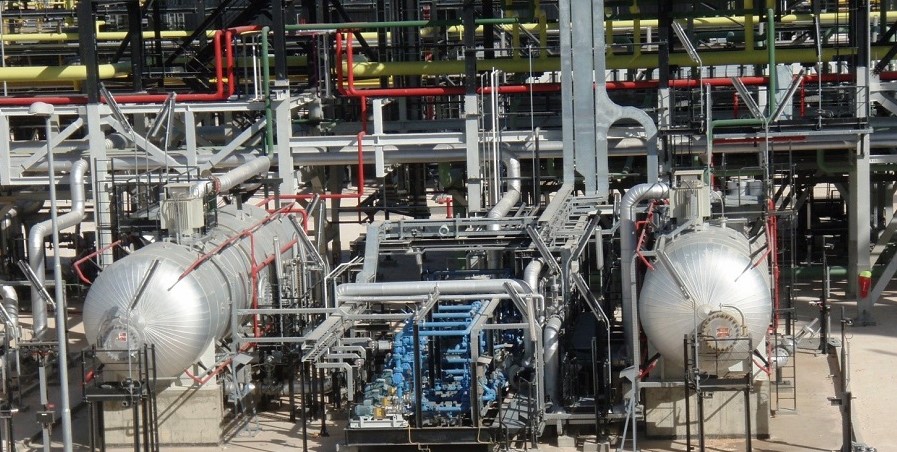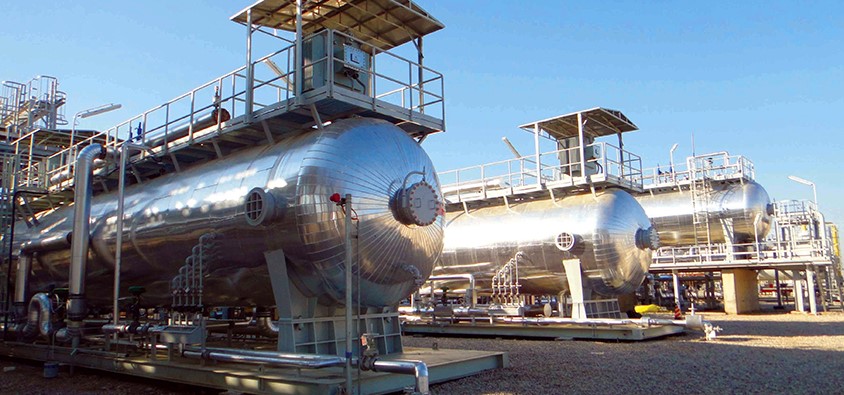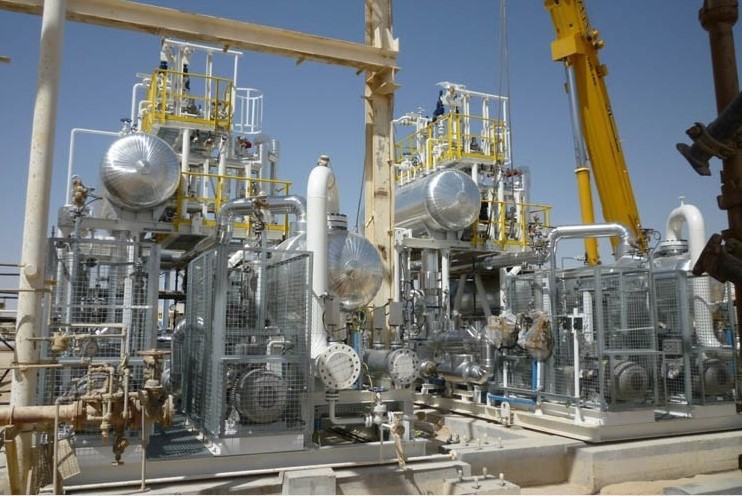بررسی اجمالی
نفت تولید شده در بیشتر میادین نفتی با آب به شکل امولسیون همراه است که باید تصفیه شود. علاوه بر این، این آب به طور معمول حاوی نمک های محلول، عمدتاً کلریدهای سدیم، کلسیم و منیزیم است. اگر نفت خام تصفیه نشده رها شود، هنگامی که در پالایشگاه فرآوری می شود، نمک می تواند مشکلات مختلف عملیاتی و نگهداری ایجاد کند.
1. در طول تبخیر ناگهانی برخی از نمک های فلزی نفت خام، دمای بالایی که در پایین دست در فرآیند رخ می دهد می تواند باعث هیدرولیز آب شود که می تواند نمک های فلزی را به اسید کلریدریک هیدرولیز کند که بسیار خورنده است. با توجه به واکنش های زیر:
2NaCl + H2O → 2 HCl + Na2O
MgCl2 + H2O → 2 HCl + MgO
CaCl معمولاً ابتدا با MgCl که به دماهای بالاتری نیاز دارد، هیدرولیز می شود. از طرف دیگر NaCl دمای هیدرولیز بالایی دارد که معمولاً در کوره بار خام به آن نمی رسد. به همین دلیل می توان Caustic یا NaOH را به جریان خام Desalter برای کاهش کلریدهای سربار تزریق کرد.
2. نمک ها و اسیدهای تکامل یافته می توانند محصولات سربار و باقیمانده را آلوده کنند و نمک های فلزی خاص می توانند کاتالیزورها را غیرفعال کنند.
3. کیک نمک از داخل تجهیزات، باعث جریان ضعیف و وصل می شود
4. اگر مقدار معینی نمک باقی بماند، ممکن است باعث ایجاد مشکلات رسوبی در لوله ها و کاهش نرخ انتقال حرارت در مبدل ها شود و باعث دمای بالای دیواره لوله هیتر شود.
5. سینی های شکنش و لوله های آتش سوزی سوخته شده.
6. فلزات از نمک همچنین می توانند باعث غیرفعال شدن کاتالیزور و تف جوشی شوند که منجر به فعالیت کمتر کاتالیزور می شود. مشخص شده است که سدیم مضرترین فلز برای کاتالیزورها است. سدیم مضرترین فلز برای کاتالیزورهاست. این کاهش در فعالیت به این معنی است که کاتالیزور استفاده شده باید بیشتر جایگزین شود تا سطح فعالیت مشخصی حفظ شود.
نمک زدایی که به دنبال آبگیری اولیه یا شکستن امولسیون انجام می شود شامل موارد زیر است:
1. اضافه کردن آب رقیق (یا نمک کمتر) به نفت خام.
2. مخلوط کردن این آب رقیق با خام برای رقیق شدن رسوبات و قطرات آب در نفت خام.
3. آبگیری (تصفیه امولسیونی) برای جداسازی فازهای نفت خام و آب نمک رقیق شده.
نتیجه این است که قطرات اصلی S&W رقیق می شود و بنابراین محتوای نمک (PTB) برای سطوح قابل مقایسه کم آبی خام کاهش می یابد. نمک زدایی را می توان در یک مرحله یا در دو مرحله انجام داد، بسته به نیازهای پالایشگاه. راندمان آبگیری یک نمک زدا معمولاً 95 درصد در یک مرحله و تا 99 درصد در دو مرحله است.

تجهیزات معمولی مورد نیاز برای نمک زدایی مرحله شامل موارد زیر است:
1. ناک اوت آب آزاد (FWKO) یا بخاری برای حذف اولیه آب نمک یا تصفیه امولسیونی.
2. سه راهی برای تزریق آب رقیق.
3. یک دستگاه اختلاط برای مخلوط کردن آب رقیق با قطرات S&W در آب نمک
4. تصفیه کننده دوم (تقریباً همیشه یک بخاری الکترواستاتیک) برای جداسازی آب خام و رقیق.
هنگام طراحی یک Desalter، نوع و اندازه آن به تعدادی از عوامل عملیاتی مانند فشار، دما، ویسکوزیته و سرعت جریان مورد نیاز و همچنین مشخصات کاربر مربوط به حداکثر مقدار نمک (PTB) مجاز در جریان روغن محصول بستگی دارد.

یک طرح فرآیند معمولی به شرح زیر ذکر شده است:
1. جریان خام خیس به مخزن مرطوب.
2. دمولسیفایر / تزریق مواد شیمیایی.
3. جریان خام به مبدل حرارتی.
4. جریان به بخاری.
5. آب بازیافت شده از ظرف مرحله 2 را بشویید.
6. جریان به مرحله 1 نمک زدایی شیر مخلوط کردن.
7. مایع مخلوط به رگ مرحله 1.
8. جریان به مرحله 2 نمک زدایی شیر مخلوط کردن.
9. آب شیرین مبدل حرارتی آب-آب از مخزن آب شستشو سرچشمه می گیرد.
10. جریان خام تصفیه شده.
11. آب خروجی از مخزن نمک مرحله 1 به تصفیه خانه آب و / یا گودال دفع.
12. سازند (رایگان) آب مستقر در پایین مخزن مرطوب، به تصفیه خانه آب و / یا گودال دفع.
در نمک زدایی تک، میزان تزریق آب رقیق مورد نیاز معمولاً 7-5 درصد دبی خام است. نمک زدایی مزرعه اغلب در مناطقی که آب شیرین کمیاب است مورد نیاز است. نمک زدایی دو مرحله ای معمولاً آب رقیق مورد نیاز را به 1-2% از نرخ جریان خام کاهش می دهد.
در نمکزدایی دو مرحلهای، آب خروجی از نمکزدای دوم، در حالی که مطمئناً غلظت بیشتری نسبت به آب رقیقسازی دارد، معمولاً نسبت به قطرات آب نمکی که در خام وارد مرحله اول میشود، شور کمتری دارد. بنابراین، آب رقت مورد نیاز را می توان با تزریق آب پساب مرحله دوم Desalter به خام قبل از مرحله اول کاهش داد. در شکل 6، جریان آب خام و رقیق با دو شمارنده Desalter در حال حاضر تماس دارند.

Overview
Oil produced in most oil fields is accompanied by water in the form of an emulsion that must be treated. In addition, this water normally contains dissolved salts, principally chlorides of sodium, calcium, and magnesium. If crude oil is left untreated, when it is processed in a refinery the salt can cause various operating and maintenance problems.
1.During flash vaporization of crude oil certain metallic salts, the high temperatures that occur downstream in the process could cause water hydrolysis that can be hydrolyzed the metallic salts to hydrochloric acid which extremely corrosive. According to the following reactions:
2NaCl + H2O → 2 HCl + Na2O
MgCl2 + H2O → 2 HCl + MgO
CaCl will typically hydrolyze first with MgCl requiring higher temperatures. NaCl on the other hand has a high hydrolyzation temperature not normally reached in a crude charge furnace. For this reason Caustic or NaOH can be injected into the Desalter crude stream to lower overhead chlorides.
2. Salts and evolved acids can contaminate both overhead and residual products, and certain metallic salts can deactivate catalysts
3. Salt cakes out inside equipment, cause poor flow and plugging.
4. If a certain amount of salt remains it may cause fouling problems in pipes and reduces heat transfer rates in exchangers, and cause high heater tube-wall temperatures.
5. Plugged fractionator’s trays and burned-out fire tubes
6. Metals from salts can also cause catalyst deactivation and sintering which result in lower catalyst activity. Sodium has been found to be the most harmful metal for catalysts Metals from salts can also cause catalyst deactivation and sintering which result in lower catalyst activity. Sodium has been found to be the most harmful metal for catalysts. This decrease in activity implies that used catalyst must be replaced more often to maintain a given activity level.

Desalting which follows the initial dehydration or emulsion breaking, consist of:
1. Adding dilution (or less saline) water to the crude oil
2. Mixing this dilution water with the crude to dilute the sediment and water droplets in the crude oil
3. Dehydration (emulsion treating) to separate the crude oil and diluted brine phases
The result is to dilute the original S&W droplets and so reduce the salt content (PTB) for comparable levels of crude dehydration .Desalting can be performed in a single stage or in two stages, depending on the requirements of the refinery. Dehydration efficiency of a Desalter is usually 95% in a single stage and up to 99% in two stages.

The conventional equipment required for stage desalting includes:
1. A free-water knockout (FWKO) or heater treater for the initial brine removal or emulsion treating
2. A tee for injecting the dilution water
3. A mixing device to co-mingle the dilution water with the S&W drops entrained in the brin
4. A second treater (nearly always an electrostatic heater treater) to separate the crude and the dilution water
When designing a Desalter, its type and size are all dependent on a number of operational factors such as required pressure, temperature, viscosity and flow rate, as well as user specification relating to maximum salt amount (PTB) allowed in the product oil stream.
A typical process scheme is mentioned as follows:
1. Wet crude flow to wet tank
2. Demulsifier / Chemical injection
3. Crude flow to heat exchanger
4. Flow to heater
5. Wash water recycled from 2nd stage vessel
6. Flow to 1st stage desalting mixing valve
7. Mixed fluid to 1st stage vessel
8. Flow to 2nd stage desalting mixing valve
9. Fresh water from water-water heat exchanger originated from wash water tank
10. Treated crude flow
11. Effluent water from 1st staged salter vessel to water treatment plant and / or Disposal pit
12. Formation (free) water settled down at the bottom of wet tank, to water treatment plant and / or disposal pit
In single desalting, the required dilution water injection rate is usually 5-7% of the crude flow rate. Field desalting is often required in regions where fresh water is the scarcest. Two stage desalting usually reduces the dilution water required to 1-2%of the crude flow rate.
In two stage desalting the water leaving the second Desalter, while certainly more concentrated that the dilution water, is usually less saline than the brine drops entrained in the crude entering the first stage. Therefore, the dilution water required can be reduced further by injecting the second stage Desalter effluent water into the crude ahead of the first stage. In figure 6, the crude and dilution water streams contact the two Desalter counter currently.


